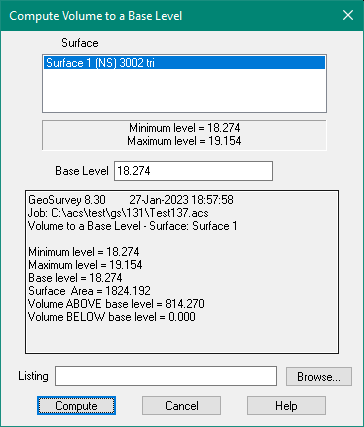Contents
Index
Volume Calculations in GeoSurvey
There are three volume calculation methods in GeoSurvey:
- Volume Between Surfaces – Gives Cut/Fill quantities between two surfaces
- Volume to a Base Level - provides ‘bulk fill’ volume of a single model or overall difference between two surfaces
- Stockpile Volume – provides ‘bulk fill’ volume of a single model
Click on one of thes items above for more detailed info:
Additional information
- Max Tri Length restriction should be BLANK (Triangle Parameters).
- Use no-contour/no-tri and boundary strings to restrict triangulation instead of setting the Max Tri Length.
- ALWAYS compute volumes using more than one independent method. Consider doing
these in different software. Don’t forget the simple common-sense approach such as calculating
surface area x average height to get a rough appreciation of what to expect.
- General rule – cut/fill interpretation:
Cut = the amount of material that has to be removed for the base surface to equal the
comparison (“Top”) surface.
Fill = the amount of material that has to be added for the base surface to equal the
comparison (“Top”) surface.
- Nett = Cut minus Fill quantity.
- “Volume to a Base Level” is generally understood to be the most accurate method.
- Stockpile volume reports in GeoSurvey do not provide cut/fill quantities.
- Adding a Boundary:
(a) Append a Boundary with no heights from another job.
(b) Change it to a Discon
(c) Interpolate heights for its points from the existing triangulation surface
(d) Revert the string to a Boundary
(e) Run final triangulation on the model
- General rule - interpolation must be done from an entire model’s triangulation surface
and not at the model fringes, otherwise incorrect heights may be obtained.

